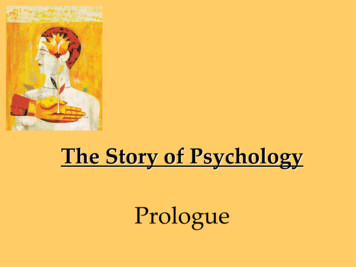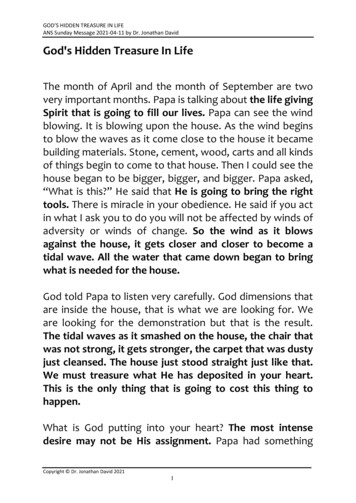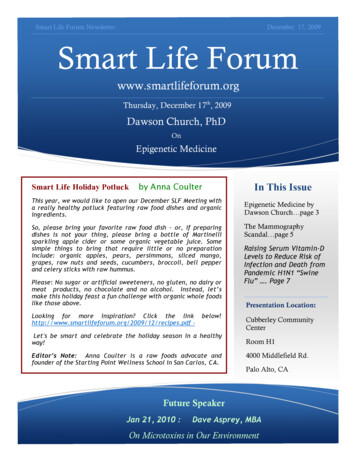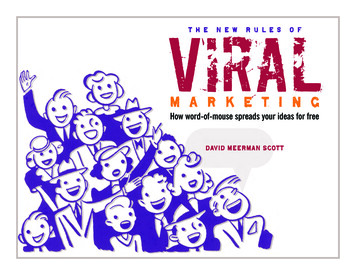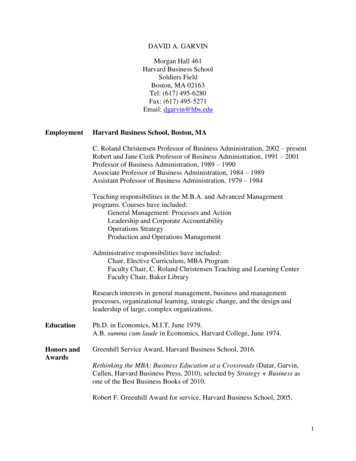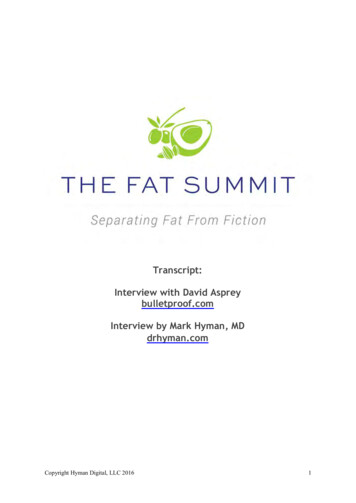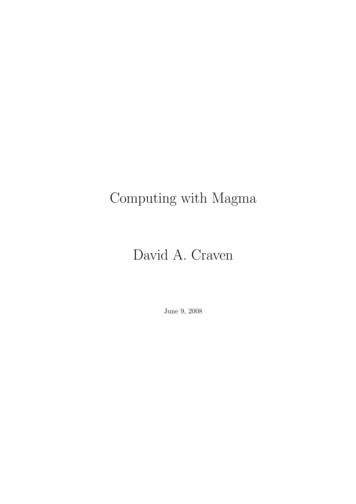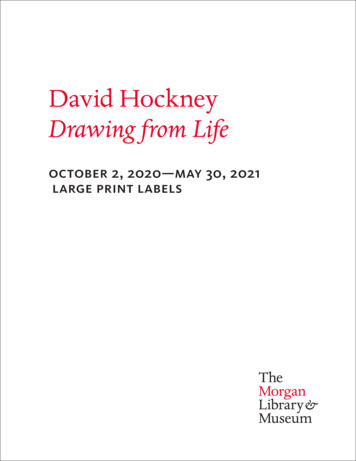
Transcription
David HockneyDrawing from LifeOctober 2, 2020—May 30, 2021Large Print Labels
Portrait of the Young Artist
Myself and My Heroes, 1961Etching with aquatintVictoria and Albert Museum, LondonWhile at the Royal College of Art in London, Hockney turnedto etching for pragmatic reasons. Students were responsiblefor purchasing their own supplies and Hockney had quicklyrun out of money thanks to his enthusiasm for painting, sohe took advantage of the college’s free printmakingmaterials. His first etching, Myself and My Heroes, embracesseveral of his passions at the time: the homoerotic poetryof Walt Whitman and the pacifism and vegetarianism ofMahatma Gandhi.
The Diploma, 1962Etching with aquatintVictoria and Albert Museum, LondonThis print marks the end of Hockney’s studies at the RoyalCollege of Art. Having been threatened with not beingallowed to graduate for failing to complete the compulsoryGeneral Studies essays, he awarded himself this parody ofa diploma. In it, he caricatured the rector, the tutor of theGeneral Studies Department, and the registrar, the latteras a monstrous maw. Below the frame are the students, bentunder the weight of these bureaucrats. Hockney did ultimatelyreceive his diploma that year, with a gold medal for painting.
My Bonnie Lies over the Ocean, 1961Etching and aquatint with collageArts Council Collection, Southbank Centre, LondonSelf-Portrait, 1962Etching with aquatintPrivate collection of Simon Aaron, LondonSelf-Portrait, 1954LithographThe David Hockney Foundation
Self-Portrait, 1954Collage on newsprintBradford Museums and Art Galleries, Cartwright HallThe self-portraits Hockney made in his teenage years, suchas the present one and the pencil drawings nearby, convey ayouthful confidence as well as the beginnings of an intenseself-scrutiny. The full-frontal pose and attention to detail inclothes and styling reflect Hockney’s burgeoning sense of hisown identity. This collage also offers a foretaste of Hockney’slater works, notably his vibrant palette and experimentationwith different media.
Self-Portrait Study, 1954Pencil on paperThe David Hockney FoundationSelf-Portrait, 1954Pencil on paperThe David Hockney FoundationSelf-Portrait, 1956Pencil on paperThe David Hockney FoundationThe Student: Homage to Picasso, 1973EtchingNational Portrait Gallery, London. Purchased, 1979
Artist and Model, 1973 74EtchingThe David Hockney FoundationFollowing Picasso’s death in April 1973, Hockney made twoetchings in the spirit of Picasso’s renowned Vollard Suite(1930 37). In the present one, Hockney depicts an imaginarymeeting with the modern master, casting himself as thenude model and using different etching techniques todistinguish the two: for Picasso, the looser “sugar-lift”method—which involves brushing the figure directly on theplate with a sugar-based fluid—and a more densely hatchedline for himself. Hockney had been taught the sugar-lifttechnique that year in Paris by Aldo Crommelynck, themaster printer of Picasso’s later etchings.
A Rake’s Progress, 1961–6316 plates, etching with aquatintThe David Hockney FoundationHockney’s first visit to the United States, in the summer of1961, provided the narrative for this semiautobiographicalseries. Inspired by William Hogarth’s 1735 engraving seriesof the same title, Hockney transformed the tale of anaristocrat who squanders his wealth into his own personalstory of a young gay man’s journey and emerging identity in1960s New York City. Although Hockney claimed that “It isnot really me. It’s just that I use myself as a model becauseI’m always around,” the etchings were partly inspired by realevents. Plate 1a records his meeting with William S.Lieberman, then curator of drawings and prints at theMuseum of Modern Art, who bought two prints from him,including Myself and My Heroes. The name “Lady Clairol” onplate 3 refers to the brand of hair dye Hockney used tobleach his hair for the first time. A range of artistic influencescan be traced, from the figures of William Blake to the artbrut of Jean Dubuffet.
From left:1 The Arrival1a Receiving the Inheritance2 Meeting the Good People (Washington)2a The Gospel Singing (Good People)Madison Square GardenThe Start of the Spending Spree andthe Door Opening for a Blonde3a The 7 Stone Weakling34 The Drinking Scene4a Marries an Old Maid5 The Election Campaign (with Dark Message)5a Viewing a Prison Scene6 Death in Harlem6a The Wallet Begins to Empty7 Disintegration7a Cast Aside8 Meeting the Other People8a Bedlam
The Artist’s Mother
Mother, Paris, 1972Colored pencil on paperThe David Hockney FoundationMy Mother, 1974Ink on paperThe David Hockney FoundationMy Parents with Trolley and Mirror, 1974Ink on paperThe David Hockney Foundation
Study for “My Parents and Myself,” 1974Colored pencil on paperThe David Hockney FoundationWhile Hockney was living in Paris intermittently from 1973to 1975, he was visited by his parents and began makingpreparatory drawings for a painting of them. His fatherworked as a clerk but was also an amateur artist andantismoking campaigner, well known for his strong politicalviews. His mother was a quiet but strong matriarchal figure.The artist inserted himself into the picture through hisreflection in the mirror on the cart.
My Parents and Myself, 1976. Oil on canvas with maskingtape; 72 72 in. (182.9 182.9 cm). The David HockneyFoundation. David Hockney, photography by RichardSchmidt.
Mother in a Yellow Jumper, 1974Colored pencil on paperThe David Hockney FoundationMother with Crossword Puzzle, June 1983, 1983Ink on paperThe David Hockney Foundation
My Mother, Bolton Abbey, Yorkshire, Nov. 1982, 1982Chromogenic print photocollageCollection of the artistThis work is a poignant reflection on mortality, set in thesame melancholy landscape that captured the imagination ofRomantic artists such as J. M. W. Turner. With thecontemplative face of Hockney’s widowed mother at center,the composition opens out to reveal the rain-drenchedheadstones and ruined abbey beyond. The multilayered,psychological portrait expresses the relationship betweenmother and son; the artist’s leather brogues in theforeground mark both his physical and emotional presenceand his connection to the sitter.
Bradford School of Art 1 (Sketchbook), 1953Pencil, ink, and wash on pages of sketchbookThe David Hockney FoundationHockney was sixteen years old when he filled the pages ofthis sketchbook, which includes some of his earliest portraits.His mother appears frequently. The scenes of family life owesomething to the intimate, domestic narratives of Frenchartists Édouard Vuillard and Pierre Bonnard.
Mum (Bridlington Sketchbook), 1994Pencil, crayon, ink, charcoal, and watercolor on pages ofspiral-bound sketchbookThe David Hockney FoundationThis sketchbook is named after the seaside town ofBridlington, East Yorkshire, where Hockney’s mother livedtoward the end of her life and where the artist had a homeand studio. Its pages are filled with private, moving portraitsof Laura Hockney sleeping or staring patiently at her son.Upon her death five years later, Hockney reflected, “Up untilyesterday I always knew exactly where my mother was. If Iwanted to have a chat with her I could phone her and shewould drop whatever she was doing to talk to me.”
Mother, Bradford. 19 Feb 1979, 1979Sepia ink on paperThe David Hockney FoundationHockney made this drawing on 19 February 1979, the dayof his father’s funeral. When he signed and dated it later,however, he mistakenly inscribed the year 1978. Relyingon a minimal line, the artist conveys the sadness in hismother’s face as she looks directly at her son. The use ofsepia ink applied with a reed pen—a possible reference toVan Gogh—gives his mother a softer, more vulnerable airthan in the earlier pen-and-ink portraits. Making a drawingwas less intrusive than taking a photograph would havebeen. Drawing had become Hockney’s way of communicatingwith his mother.
Mum, 10 March 94, 1994Crayon on paperThe David Hockney Foundation
Gregory
Gregory Sleeping Nude, Fire Island, 1978Ink on paperThe David Hockney FoundationGregory Reclining, Fire Island, 1978Ink on paperThe David Hockney FoundationGregory Sleeping, Fire Island, 1978Ink on paperThe David Hockney FoundationGregory, 1974Colored soft-ground etchingArts Council Collection,Southbank Centre, London
Gregory. Palatine, Roma. Dec. 1974, 1974Ink on paperPrivate collection, Bruxelles, Belgium, courtesy of L.A.Louver, Venice, CaliforniaGregory has been the artist’s traveling companion in Europeand farther afield. In this drawing, made in Rome early intheir relationship, Hockney used a spare, unbroken line inpen and ink to capture his fascination with his new lover.
Gregory Leaning Nude, 1975Colored pencil on paperCollection of Gregory EvansThis full-length portrait of Gregory draws on the Renaissanceideal of youthful, male beauty, seen for instance in Raphael’searly sixteenth-century drawing after Michelangelo’s David.At the time he made it, Hockney was living mostly in Parisand going through a phase he described as “obsessivenaturalism,” partly influenced by his frequent visits to theLouvre nearby.
Gregory, Sleeping (Mustique Sketchbook), 1985Ink on pages of linen-bound sketchbookThe David Hockney FoundationIn February 1985, Hockney and Gregory visited the New Yorkart dealer Nathan Kolodner on the Caribbean island ofMustique. “When I went on holiday to Mustique,” Hockneyrecounted, “I went for a rest and had no intention to work;but I never really stop. . . . You sit around, you sit talking topeople; then I tend to pick up the sketchbook and startdrawing in it. I have never started with the idea of filling onebook with one thing.” The Mustique Sketchbook includesfigure studies, portraits, and still lifes in pastel, crayon,and ink. It also contains drawings made later that year inMexico City.
Gregory in Golf Cap, 1976Ink on paperPrivate collection c/o Clore WyndhamGregory, 1978Colored pencil on paperThe David Hockney FoundationGregory with Gym Socks, 1976LithographThe David Hockney FoundationSmall Head of Gregory, 1976LithographThe David Hockney Foundation
Gregory, Los Angeles, March 31st 1982, 1982Composite PolaroidCollection of the artist“The moment you make a collage of photographs,” Hockneysaid, “it becomes something like a drawing.” In February1982, he began assembling Polaroids into grids to form whathe called “joiners,” composite images in which eachphotograph shows a detail of the subject. The process ofselection and juxtaposition produces a more complex,multilayered portrayal than a single photograph, which theartist found “too devoid of life.” Hockney made portraits ofhis favorite models using this technique (see the compositePolaroids of Celia and Maurice elsewhere in this exhibition),but after a few months he abandoned the rigidity of the gridin favor of freer types of photocollages.
Gregory Evans, 1976LithographThe David Hockney FoundationAn Image of Gregory, 1984Lithograph on two sheets of paperThe David Hockney FoundationGregory, 1977Charcoal on blue paperThe David Hockney FoundationGregory, London, 1980Ink on paperCollection of the artist
Gregory, 1976Ink on paperCollection of Gregory EvansGregory, 1979Ink on paperCollection of Gregory Evans
Gregory in the Pool (Paper Pool 4), 1978Colored pressed paper pulpPrivate collectionBetween August and October 1978, Hockney collaboratedwith master printer Ken Tyler on a series of twenty-nineworks made from colored and pressed paper pulp. The artistused this method, which fused painting and papermaking, tocreate a watery medium that evoked the iridescent surface ofthe swimming pool on the grounds of Tyler’s studio.Cloisonné-like metal molds based on Hockney’s preparatorydrawings were placed over newly made paper to receive theliquid color pulp. Gregory assisted with the project andbecame the subject of several of the works.
Gregory II, 1988Pencil on paperCollection of the artistThis portrait and the adjacent one are two of four drawings ofGregory that Hockney produced in quick succession. Thedistortion of the figure suggests that the artist is circling hissubject. Gregory’s elongated face and hangdog expression, aswell as his fingers digging into his forearm, may indicate thathe had become a more reluctant sitter than he had beentwenty years earlier.
Gregory I, 1988Pencil on paperCollection of the artistGregory, 1984Charcoal on paperCollection of the artistGregory Evans, 27 June 1994, 1994Crayon on paperCollection of the artistEspaña (Spain) January 2004, 2004Watercolor on sketchbook pageThe David Hockney Foundation
Gregory Evans. London. 12th December 1999, 1999Pencil and colored pencil on paper, using a camera lucidaThe David Hockney Foundation
Gregory Evans. Los Angeles. 18th September 1999, 1999Pencil and gouache on paper, using a camera lucidaThe David Hockney FoundationIn 1999, after seeing an exhibition of portraits by thenineteenth-century French artist Jean-Auguste-DominiqueIngres at the National Gallery in London, Hockney becameconvinced that Ingres had made his portraits using a cameralucida. The optical instrument, which consists of a tiny prismsuspended on the end of a flexible metal rod, had beeninvented in 1806 as a measuring device for artists. Adoptingit himself, Hockney could make quick notations to fix theposition of the eyes, nose, and mouth of each sitter. Within ayear he had drawn 250 portraits using a camera lucida, all inpencil, sometimes enhanced with white crayon, watercolor,or gouache.
Gregory Evans I. London. 13th June 1999, 1999Pencil on paper, using a camera lucidaThe David Hockney FoundationGregory Evans, 24 December 2012, 2012Charcoal on paperCollection of Gregory EvansGregory Reading. Vestrefjord, 2003Watercolor on paperCollection of the artist
Celia
Celia, Paris, 1969Ink on paperThe Morgan Library & Museum, gift of Katharine J
02.10.2020 · Large Print LabeLs. Portrait of the Young Artist. Myself and My Heroes, 1961 Etching with aquatint Victoria and Albert Museum, London While at the Royal College of Art in London, Hockney turned to etching for pragmatic reasons. Students were responsible for purchasing their own supplies and Hockney had quickly run out of money thanks to his enthusiasm for painting, so he took advantage of
